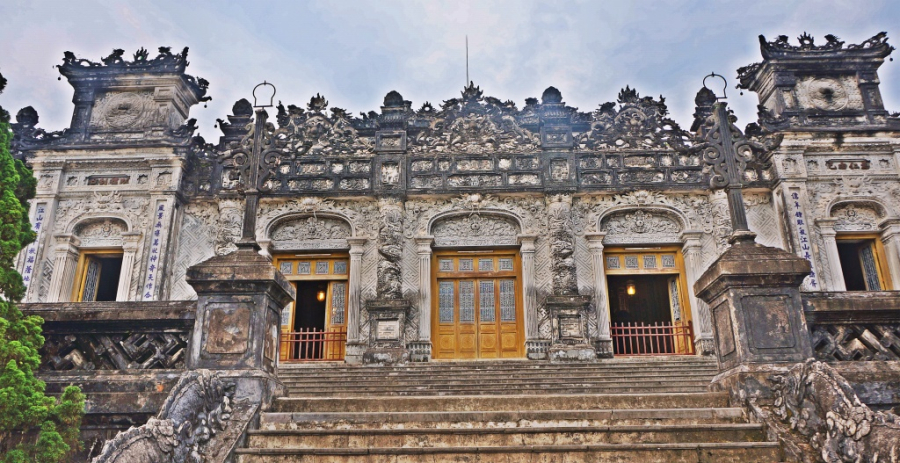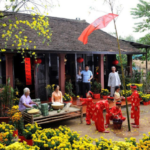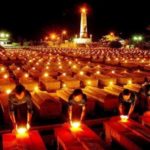Located on the top of Chau Chu Mountain, about 10km from the center of Hue City, Khai Dinh Tomb – also known as Ung Lang – is the final resting place of the 12th king of the Nguyen Dynasty, King Khai Dinh. Designed in a unique style and adorned with exquisite porcelain artwork, Khai Dinh Tomb offers an impressive and attractive beauty that draws thousands of visitors to explore each year.
Construction history
King Khai Dinh (1885 – 1925), born in the imperial capital of Hue in the year At Dau, ascended the throne in 1916 and became the 12th king of the Nguyen Dynasty with the name Phuc Tuan. During his reign, Khai Dinh constructed many monumental architectural works, among which Khai Dinh Tomb in Hue stands out.
Since taking over the throne from his father King Dong Khanh, Khai Dinh had been contemplating the construction of his final resting place. He invited geographical experts to calculate and consult opinions in order to choose the most suitable location for the tomb. Eventually, King Khai Dinh decided to select the mountain range in the Chau Chu area as the site for building the mausoleum.

Khai Dinh Tomb was started construction in September 1920 on the Chau Chu Mountain (also known as Chau E), belonging to Thuy Bang commune, Huong Thuy town, Hue. It is a tranquil and spacious place, surrounded by attractive tourist destinations such as Thuy Tien Lake, Thien An Hill, and the spiritual area of Quan Am Bodhisattva. The construction of Khai Dinh Tomb lasted for 11 years and was only completed in 1931 (Tan Mui). The completion of Khai Dinh Tomb can be attributed not only to the main architects but also to the dedication of many skilled craftsmen and famous artisans from all over the country. Until today, Khai Dinh Tomb Hue still preserves many historical, cultural, and artistic values, exemplifying the cultural exchange between Vietnam and Western countries at that time.
Unique architecture
Khai Dinh Tomb, one of the precious cultural heritages of the former imperial capital Hue, has been honored by UNESCO as a World Cultural Heritage. The unique architecture of this mausoleum, with its exquisite details, has created an artistic masterpiece that cannot be replicated by any image. In order to truly appreciate the beauty and uniqueness of the overall design, visitors need to come in person and witness it with their own eyes. Khai Dinh Tomb, with its innovative and distinctive design, has become a rare symbol among the Nguyen Dynasty tombs.
The tomb of King Khai Dinh, a magnificent architectural work, is built in the form of a prominent rectangular block, located atop 127 steps. The main materials used in the construction of this work include cement, iron, steel, as well as imported ceramics and glass from Japan and China. Some roofing tiles were even ordered from France. These elements have contributed to the uniqueness and distinctiveness of King Khai Dinh’s tomb, reflecting his lavish lifestyle in the past.
Ung Lang, like other Nguyen Dynasty tombs, also features a system of royal statues, martial figures, court officials, and solemn elephant statues guarding the courtyard, just below the king’s worship area. This familiar feature contributes to the dignity and gravitas of the tomb space.
The worship area of King Khai Dinh, located in the solemn space of Thien Dinh Palace at Ung Lang, is decorated in a magnificent manner with vivid and delicate patterns. The worship objects, crafted from precious materials, not only demonstrate the exquisite craftsmanship but also reflect the respect and solemnity in worshiping King Khai Dinh.
Thien Dinh Palace, with its prime location and impressive architecture, is no surprise as the top attraction at Ung Lang. It is the tallest and most significant architectural structure within the tomb complex. Khai Thanh Palace, located right in front of Thien Dinh Palace, houses the worship tablet and the portrait of King Khai Dinh. At the center of the palace is Buu An, where the statue of King Khai Dinh is placed. This statue, sculpted by the French sculptor Paul Ducuing and cast at Ferdinand Barbédienne’s workshop in Paris at the king’s request, is made of gold and bronze. It depicts King Khai Dinh sitting on a golden throne, wearing a dragon robe, a nine-dragon hat, and holding a scepter, creating a dignified and majestic image.
Ung Lang, an appealing destination with many unique highlights, includes the beautiful painting “Cu Long An Van” (Nine Dragons Hidden in Clouds). This painting is engraved on the middle ceiling of Thien Dinh Palace, creating an impressive artistic space. “Cu Long An Van,” with its majestic depiction of dragons, not only highlights the beauty of Ung Lang but is also regarded as one of the largest and most impressive dragon paintings in Vietnam today.

The painting “Cu Long An Van” at Ung Lang, a unique work of art, was carved by the imperial court artist Nguyen Van Tanh, according to archival materials. Interestingly, despite almost a century having passed, this painting still retains its pristine beauty, never having been touched by any restorative efforts, as if time has left no trace. Furthermore, a mysterious fact is that, although the area surrounding Thien Dinh Palace is frequented by spiders, this painting shows no sign of spider webs, creating an intriguing story about the preservation of this artistic heritage.
Khai Dinh Tomb, an ancient architectural monument, is a delicate combination of various cultures, materials, and designs. It is not only a symbol of history but also a prominent highlight in the journey to explore Hue, offering visitors fascinating and captivating experiences.
Explore 12 Amazing Destinations for Biking Trips
Unlock Vietnam in a brand new way with an exciting biking tour! Discover the stunning beauty of the country with Dien May XANH’s top 12 must-see destinations. From sweeping plains to clear blue beaches and mountainous vistas – experience all the sights with your own personal cycling tour. Find your ideal route and set out for an adventure today!






































